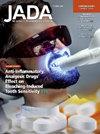社交媒体平台上的正畸信息质量可靠吗?系统综述。
IF 3.1
2区 医学
Q1 DENTISTRY, ORAL SURGERY & MEDICINE
引用次数: 0
摘要
背景:社交网络已成为患者广泛使用和获取健康相关信息的来源,但这些信息并不总是准确或恰当的。本研究的目的是评估在两个最流行的社交媒体平台上提供的正畸信息的质量:作者在 PubMed、Embase 和 Scopus 等电子数据库中对分析社交网络上正畸信息质量的文献进行了系统检索,并使用了公认的质量评估方法,如 DISCERN、修改后的 DISCERN、质量总体量表或视频信息质量指数,并通过手动检索灰色文献:作者共发现了 534 篇可能符合条件的文章,其中 22 篇最终被纳入定性分析。量表的应用表明,大部分内容质量不高,缺乏科学严谨性、精确性和可靠来源的支持。作者观察到所分析的出版物在性质上存在明显的异质性,最常见的主题是普通正畸治疗和透明矫治器的使用:实际意义:社交媒体平台为患者提供了低质量的信息,这可能是有害的。这些发现强调了在治疗前和治疗过程中提供其他方式来解决患者疑问的必要性,并突出了促进有关正畸治疗在线信息的知情和负责任教育的重要性。本文章由计算机程序翻译,如有差异,请以英文原文为准。
Is the quality of the orthodontic information in social media platforms reliable?
Background
Social networks have become a widely used and accessible source of health-related information for patients, but this material is not always accurate or appropriate. The purpose of this study was to evaluate the quality of orthodontic information available on 2 of the most popular social media platforms.
Studies Reviewed
The authors conducted a systematic search of the literature that analyzed the quality of information regarding orthodontics on social networks and used recognized quality-evaluation methods, such as DISCERN, modified DISCERN, and the Quality Global Scale or the Video Information Quality Index, in the electronic databases of PubMed, Embase, and Scopus and through a manual search of gray literature.
Results
The authors identified a total of 534 potentially eligible articles, of which 22 eventually were included in the qualitative analysis. The application of the scales revealed that most of the content was of insufficient quality and lacked scientific rigor, precision, and support from reliable sources. The authors observed marked heterogeneity in the nature of the publications analyzed, with the most recurrent topics being general orthodontic treatment and the use of clear aligners.
Practical Implications
Social media platforms provide low-quality information to patients, which potentially can be harmful. These findings underscore the need to offer alternative ways to resolve patient queries before and during treatment and highlight the importance of promoting informed and responsible education regarding online information on orthodontic treatments.
求助全文
通过发布文献求助,成功后即可免费获取论文全文。
去求助
来源期刊

Journal of the American Dental Association
医学-牙科与口腔外科
CiteScore
5.30
自引率
10.30%
发文量
221
审稿时长
34 days
期刊介绍:
There is not a single source or solution to help dentists in their quest for lifelong learning, improving dental practice, and dental well-being. JADA+, along with The Journal of the American Dental Association, is striving to do just that, bringing together practical content covering dentistry topics and procedures to help dentists—both general dentists and specialists—provide better patient care and improve oral health and well-being. This is a work in progress; as we add more content, covering more topics of interest, it will continue to expand, becoming an ever-more essential source of oral health knowledge.
 求助内容:
求助内容: 应助结果提醒方式:
应助结果提醒方式:


